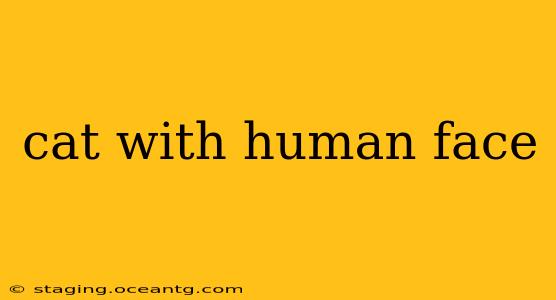The internet is awash with images of cats that seemingly possess human-like faces. These captivating felines, with their striking features, often go viral, sparking discussions about genetics, rare conditions, and the power of perception. But what's behind these intriguing visuals? This article delves into the science and the social media sensation surrounding cats with human-like faces.
What Causes a Cat to Have a Human-Like Face?
The "human-like" appearance in cats isn't usually due to a single, identifiable genetic mutation. Instead, it's a combination of factors that create a striking resemblance to human facial features. These factors can include:
-
Facial Structure: Certain breeds, due to selective breeding, have facial structures that naturally lend themselves to a more human-like appearance. Breeds with flatter faces, like Persians or Himalayans, can sometimes exhibit features that are more prominent and closer together, creating an illusion of resemblance.
-
Fur Pattern and Color: The arrangement of fur, particularly around the eyes, nose, and mouth, plays a significant role. Patches of lighter or darker fur can emphasize certain areas of the face, creating an effect that resembles human facial expressions or characteristics.
-
Angle and Lighting: The angle from which a photograph is taken and the lighting conditions significantly impact how a cat's face appears. A cleverly captured photograph can enhance the illusion of a human-like expression.
-
Pareidolia: Let's not forget the powerful role of pareidolia—the psychological phenomenon where we perceive familiar patterns in random stimuli. We're naturally inclined to see faces in things, even where they don't objectively exist. This likely contributes to the widespread fascination with these cats.
Are There Any Specific Genetic Conditions?
While no specific genetic condition directly results in a cat having a "human face," certain genetic anomalies can influence facial structure. However, these anomalies are usually associated with other health issues and aren't solely responsible for the human-like appearance many people perceive. It's crucial to remember that associating a cat's appearance with a specific medical condition requires professional veterinary assessment.
Why Do Cats with Human Faces Go Viral?
The viral nature of these images stems from several factors:
-
Anthropomorphism: Humans are inherently drawn to anthropomorphize animals, attributing human characteristics and emotions to them. Cats with human-like faces intensify this tendency, making them particularly engaging.
-
Unexpectedness: The unusual appearance is inherently surprising and captivating. This unexpectedness triggers curiosity and a desire to share the image with others.
-
Social Media Algorithms: Social media algorithms are designed to amplify viral content. Images of cats with human-like faces, due to their novelty and emotional appeal, tend to generate significant engagement, further fueling their spread.
Is there a specific breed of cat known for human-like faces?
No, there isn't a specific breed known for having human-like faces. The resemblance is primarily due to a combination of the factors mentioned above, including breed characteristics, fur patterns, photographic angles, and pareidolia.
Can I breed a cat with a human-like face?
Attempting to selectively breed for a "human-like" face in cats isn't recommended. Focus should always be on the overall health and well-being of the animals, not on achieving an aesthetic that's largely subjective and potentially linked to underlying health issues. Responsible breeding prioritizes the genetic health and temperament of the breed, not superficial characteristics.
In conclusion, the phenomenon of cats with human-like faces is a captivating blend of genetics, perception, and social media dynamics. While no specific gene creates this resemblance, a confluence of factors contributes to the illusion. The viral nature of these images underscores our innate tendency to anthropomorphize and our fascination with the unusual. It's a reminder of the power of perception and the enduring appeal of our feline companions.
